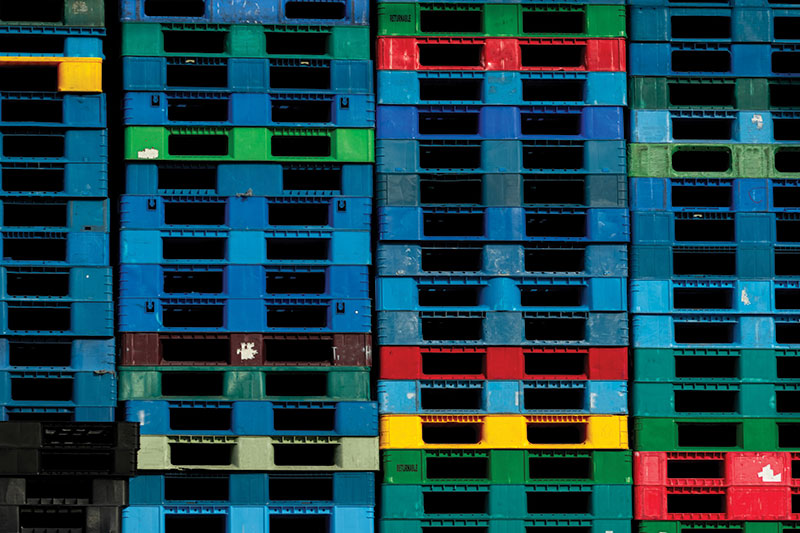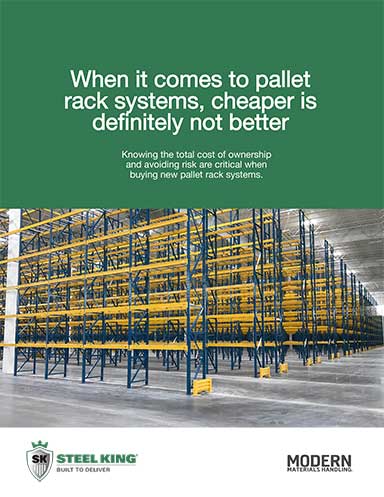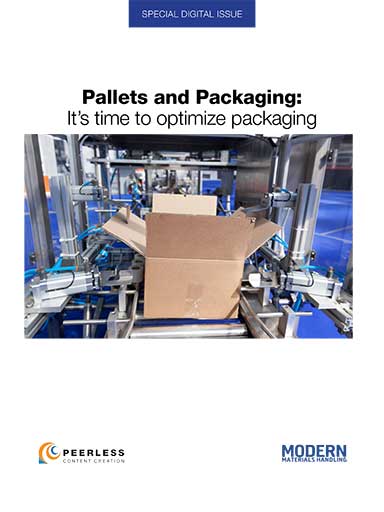The Pallet Report 2023: Shape shift underway
New report reveals the types and sizes of pallets that companies are using, mechanisms used to secure the loads on the pallets and the broader role pallets are playing in global supply chains.
Regardless of how much technology, robotics and automation make their way into the modern warehouse, there’s still an ongoing need for a fundamental conveyance used to safely and securely transport goods from place to place. For this and various other reasons, pallets of various sizes and made from different types of materials remain a mainstay for most distribution operations.
Made from wood, plastic, metal, wood composites or corrugated cardboard, pallets help companies increase storage efficiency, protect products from damage, facilitate the smooth flow of goods through the supply chain and improve inventory tracking (e.g., by assigning unique identifiers for every pallet). Pallets also keep products off the ground and ultimately ensure orders arrive at their destinations in good condition.
Knowing the critical role pallets play in warehouses and distribution centers, Modern Materials Handling conducts an annual study to learn more about how companies are procuring and using pallets. This marks the 13th year Modern has been fielding the survey, and every year the publication gleans the most interesting points from the survey and encapsulates them in this Pallet Report.
This year’s study, conducted by Peerless Research Group, covers the factors that go into the pallet selection process; the most/least used pallet types; companies’ expected level of pallet usage over the next two years; recent changes in pallet usage patterns; and how companies outside of the United States are buying and using this warehouse staple.
Tracking market shifts
This year, 160 Modern readers participated in the publication’s annual pallet usage survey. Respondents are primarily employed in manufacturing (53%), wholesale trade (13%) or retail (9%). They work in a variety of industries, including food, beverage and tobacco; automotive and transportation equipment; industrial machinery; and chemicals/pharmaceuticals.
The majority of respondents work for companies with less than $10 million in revenues (29%) or for organizations with anywhere from $10 million to $49.9 million in revenues (19%). At the larger end of the scale, 6% of respondents are with organizations that have $2.5 billion or more in annual revenues.
According to the survey, most respondents (94%) are using wood pallets at their organizations—a percentage consistent with prior year’s survey results. In addition, 38% are using plastic pallets (up from 31% last year), 19% use wood composite pallets (up from 17% last year), 4% use metal pallets and 5% use cardboard or corrugated pallets.
Compared to prior years, companies appear to be using different pallet sizes and are moving away from the traditional 48 x 40-inch pallet. This year, 70% of respondents say they commonly use 48 x 40 pallets (down from 77% last year), however 40% say they commonly use 48 x 48-inch in 2023, up from 27% in 2022.
Other readers (11%) typically use 42 x 42-inch pallets (down from 19% last year), while 12% employ 36 x 48-inch pallets and 10% most commonly use 36 x 36-inch (up from 6% last year). Nine percent say they typically use half pallets (24 x 20-inch), and 18% use another unlisted size.
New or used pallets?
Some companies prefer new pallets, others prefer used and still others use a combination of the two. Overall, 56% of companies say they purchase new wood pallets, while 71% acquire used or core wood pallets. This year, 15% are using a pallet pool—up from 8% last year.
Of those respondents buying used pallets, 35% say fewer used pallets are available or that used options are in short supply. Also, 33% say the quality of used pallets is not as good as new pallets, and 45% say used pallets are more expensive. About 16% of companies are currently experiencing “zero issues” procuring used pallets, up from 40% in 2020, when the pandemic was impacting many global logistics and transportation operations.
According to the survey, 44% of companies are using more used pallets than they did one year ago (compared to 51% last year), while 38% are using about the same amount and 17% are using fewer used pallets than last year (compared to 8% last year).
Plastic pallets
As companies weigh out their pallet material options, 63% of them are using the same number of plastic pallets they were using in 2022. Fourteen percent are using more plastic pallets than they did last year, and 24% are using fewer plastic pallets.
Over the next 12 months, 61% of respondents expect their plastic pallet usage to stay the same, while 21% expect a decrease in usage and 14% expect to use more plastic pallets. Five percent of respondents plan to begin using plastic pallets in the next 12 months.
Of those companies planning to increase their plastic pallet usage in the coming months, most say the shift is happening as a result of compliance issues (27%). Others see plastic pallets as being more sustainable than wood pallets (19%) and still others like the durability that plastic pallets offer (17%). Other companies want to use more plastic pallets to gain greater control over their pallets (13%) or because customers are asking for them (12%).
Pallet retrieval and rental
This year’s survey found that the majority of companies (76%) don’t currently rent pallets, nor do they plan to rent pallets or work with a retrieval/recovery provider. Eight percent of companies are using a pallet rental company (down from 12% last year), and 15% use some other type of pallet retrieval or recovery system.
Just more than half (58%) of this year’s survey participants don’t plan to use a pallet retrieval/recovery system or a third-party rental system within the next 12 months. However, 27% say it’s either “highly likely” or “likely” they will use a pallet retrieval/recovery system or a third-party rental system within the next 12 months, while 16% of respondents say they don’t know what these systems are.
Going global
Fifty-three percent of companies surveyed solely ship domestic shipments, while 1% ship strictly internationally and 46% send both domestic and international shipments. Of those companies that ship internationally, most are sending goods to Canada (81%); Mexico, South America and the Caribbean (71%); and China, Japan, Southeast Asia, North Asia and Australasia (69%).
This year, 37% of respondents are shipping to the Indian subcontinent (up from 19% last year), while 53% are shipping to Western Europe (up from 38% last year) and 36% say they’re shipping to the Middle East and North Africa (up from 24% last year).
Over the next two years, 58% of companies expect the number of pallets they ship internationally to increase (up from 48% in 2022), while 37% expect the number to stay the same. And 5% of companies expect a decrease.
When shipping internationally, many companies take additional measures with their pallets. Forty-five percent of respondents have their pallets treated when shipping internationally, for example, and 26% use plastic, corrugated, pressed wood or metal pallets rather than wood. Twenty-one percent use their own wood pallets when shipping internationally, while 19% use the similar methods when shipping domestically and internationally.
Over the past two years, 42% of respondents say they have increased their number of pallets shipped internationally, while 47% say the number has stayed the same. And, 11% have decreased the number of pallets they ship internationally.
Going above and beyond
Seventeen percent of this year’s survey respondents say they’re using (or have used in the past) a third-party service to help them better understand the pallet and transport packaging combination (i.e., stretch wrap, shrink wrap, banding, etc.) that’s best suited to their operation.
When asked how interested they are in such third-party services, 8% of respondents are either “extremely” or “very” interested and 24% are somewhat interested. The survey also found that 68% of companies are either “not very” or “not at all” interested in learning more about these types of third-party services.
Beyond providing pallets, providers are also offering onsite recycling and reclamation process management (34%), vendor managed pallet inventory/just-in-time delivery (28%) and backhauls (22%). Additionally, 10% of companies say their pallet providers offer onsite crate assembly and delivery to the manufacturing line, while 10% offer data or information related to their supply chain networks.
Stabilizing loads
Companies ship and receive different types of packaging on pallets, including corrugated boxes (70%), bags (16%), drums (16%), plastic totes/RPCs (12%) and pails (14%). Eight percent of respondents use flexible intermediate bulk containers (FIBCs) and 35% use some other type of packaging.
When shipping corrugated boxes, 53% most frequently use 48 x 40-inch pallets, while 15% use 48 x 48-inch, and 10% use 42 x 42-inch. When shipping plastic, metal or fiber pails, 37% use 48 x 40-inch pallets, while 29% use 48 x 48-inch and 13% use 42 x 42-inch to transport pails. When shipping plastic totes/RPCs, 41% use 48 x 40-inch pallets, while 31% use 48 x 48-inch most frequently and 6% use 42 x 42-inch.
The majority (71%) of respondents say they don’t experience unit load stability issues in their supply chains while 29% indicate they do struggle with unit load stability. Of the companies that do experience unit load stability issues, 29% experience them weekly, while others deal with them on a monthly (21%) or quarterly (16%) basis.
To stabilize the loads, most companies use stretch film (65%), shrink film (46%) or strapping/banding (40%). Others use tie sheets (10%), interlocking (9%), stretch hood (6%), shrink hood (6%) or lock’n pop adhesive (3%).
Forty-six percent of respondents do all of their stretch wrapping manually (down from 53% last year), while 25% say they have some automated stretch wrappers and 23% say all their operation uses semi- or fully automated stretch wrappers (up from 17% last year).





















